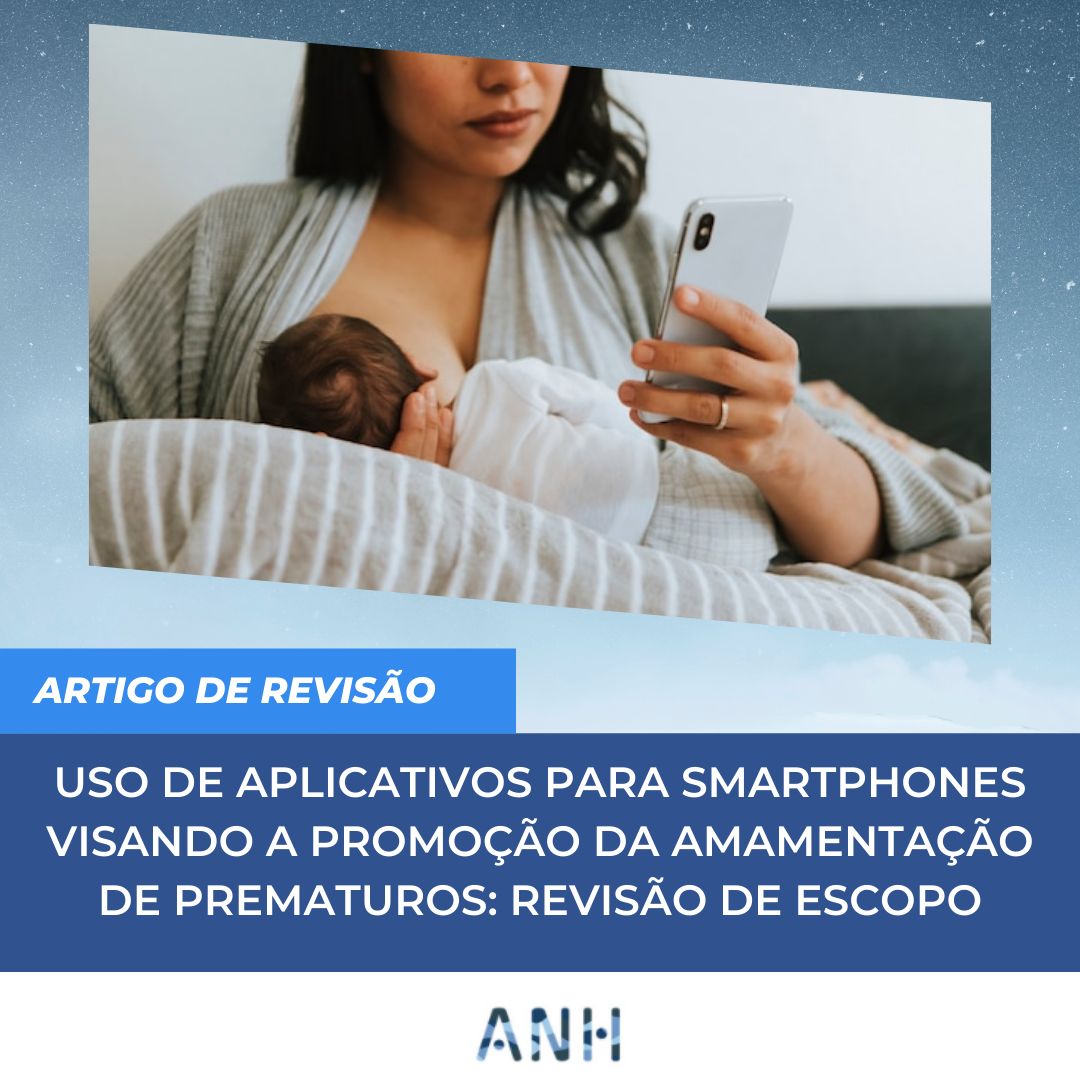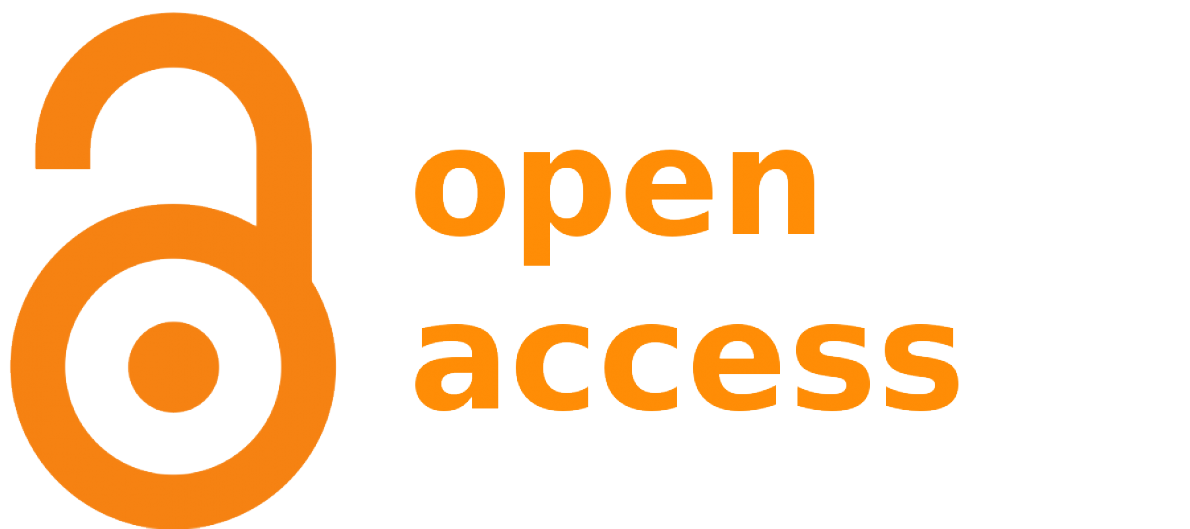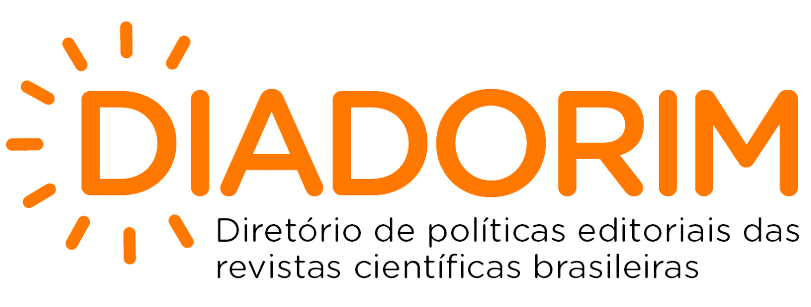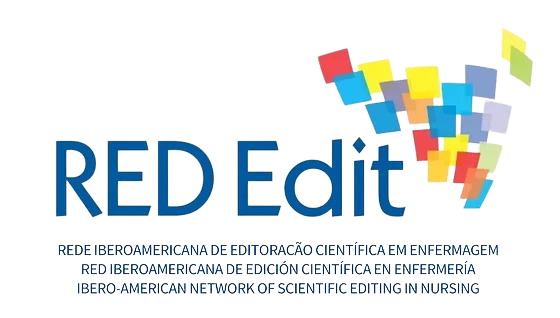USE OF SMARTPHONE APPLICATIONS TO PROMOTE BREASTFEEDING IN PRETERM INFANTS: A SCOPING REVIEW
DOI:
https://doi.org/10.5433/anh.2022v4.id43664Keywords:
Aplicativos móveis, Aleitamento Materno, Recém-nascido prematuro, Período pós-parto, Tecnologia Educacional, Promoção da SaúdeAbstract
Aim: Systematize the available productions on the use of smartphone applications for promoting breastfeeding in preterm infants. Method: Scoping review conducted in September and October 2019 in the databases: CINAHL, MEDLINE, Scopus, and PubMed. There was no language or time limitation. In addition to the search for scientific production on this theme, a search was conducted on the download platforms of the two hegemonic smartphone operating systems - Google Play Store (Android) and Apple App Store (iOS). In March 2020, the same search strategy was replicated to verify whether new papers have been published from protocol results, as well as to identify new studies or protocols. Results: The search resulted in 764 documents, of which two articles and three protocols were included in the review. The number of studies found confirms the scarcity of scientific production on apps specifically aimed at the preterm infant population, although they point to a current growing trend to incorporate this resource for the breastfeeding promotion and support. The selected studies showed no statistically significant differences in breastfeeding rates when using such resources compared to in-person care. More studies are needed to evaluate different application proposals and in different settings to analyze the effectiveness of this technological resource as a complement to conventional care. Conclusion: The available productions on the use of apps to promote and manage breastfeeding in preterm infants are very scarce. The information available to assess the effect of this type of resource to promote breastfeeding in this population is considered insufficient.
Downloads
References
2. Brasil. Ministério da Saúde. Secretaria de Atenção à Saúde. Departamento de Atenção Básica. Saúde da criança: aleitamento materno e alimentação complementar. Cadernos de Atenção Básica. [Internet] 2015 [acesso 2019 nov 10]. 184 p. Disponível em: https://bvsms.saude.gov.br/bvs/publicacoes/saude_crianca_aleitamento_materno_cab23.pdf
3. Oriá MOB, Dodou HD, Chaves AFL, Santos LMDA dos, Ximenes LB, Vasconcelos CTM. Eficácia de intervenções educativas realizadas por telefone para promoção do aleitamento materno: revisão sistemática da literatura. Rev Esc Enferm USP. 2018 [acesso 2019 Dez 10];52(0): e03333. Disponível em: https://www.scielo.br/pdf/reeusp/v52/1980-220X-reeusp-52-e03333.pdf
4. Pereira LB, Abrão ACFV, Ohara CVS, Ribeiro CA. Maternal experiences with specificities of prematurity that hinder breastfeeding. Texto Context - Enferm. [Internet]. 2015 [acesso 2020 nov 10];24(1):55-63. Disponível em: https://doi.org/10.1590/0104-07072015000540014
5. Brasil. Ministério da Saúde. Secretaria de Atenção à Saúde. Departamento de Ações Programáticas e Estratégicas. II Pesquisa de Prevalência de Aleitamento Materno nas Capitais Brasileiras e Distrito Federal. [Internet]. 2009 [acesso 2019 Dez 12]. Disponível em: https://www.nescon.medicina.ufmg.br/biblioteca/imagem/4416.pdf
6. Brasil. Ministério da Saúde. Secretaria de Atenção à Saúde. Departamento de Ações Programáticas e Estratégicas. Atenção humanizada ao recém-nascido de baixo peso : Método Canguru : manual técnico. [Internet]. 2013 [acesso 2019 nov 10]. Disponível em: http://bvsms.saude.gov.br/bvs/publicacoes/atencao_humanizada_recem_nascido_canguru.pdf
7. Brusco TR, Delgado SE. Caracterização do desenvolvimento da alimentação de crianças nascidas pré-termo entre três e 12 meses. Rev CEFAC. [Internet] 2014 [acesso 2019 nov 10];16(3):917-28. Disponível em: https://doi.org/10.1590/1982-021620145313
8. Fujinaga CI, Maltauro S, Stadler ST, Cheffer ER, Aguiar S, Amorin NEZ, et al. Behavioral state and the premature's readiness performance to begin oral feeding. Rev CEFAC. [Internet]. 2018 [acesso 2019 dez 10];20(1):95-100. Disponível em: https://doi.org/10.1590/1982-021620182015317
9. Silveira MF, Matijasevich A, Horta BL, Bettiol H, Barbieri MA, Silva AA, et al. Prevalence of preterm birth according to birth weight group: A systematic review. Rev Saude Publica. [Internet] 2013 [acesso 2019 nov 10];47(5):992-1000. Disponível em: https://doi.org/10.1590/S0034-8910.2013047004997
10. GUSMÃO ECR. Construção e validação de um aplicativo de identificação das habilidades adaptativas de crianças e adolescentes com deficiência intelectual. [Dissertation on the Internet] Belo Horizonte; 2019 [acesso 2019 nov 10];1-201. Disponível em: https://repositorio.ufmg.br/handle/1843/ENFC-BCDJHA
11. Escamirosa FP, Flores RO, Martínez AM. Construction and validation of a low-cost surgical trainer based on iphone technology for training laparoscopic skills. Surg Laparosc Endosc Percutan Tech. [Internet] 2015 [acesso 2019 dez 10];25(2):78-82. Disponível em: https://pubmed.ncbi.nlm.nih.gov/25738702/
12. World Health Organization. mHealth: New horizons for health through mobile technologies: second global survey on eHealth. Global Observatory for eHealth series - Volume 3. [Internet]. 2011 [acesso 2019 dez 10]. Disponível em: https://www.who.int/goe/publications/goe_mhealth_web.pdf
13. Schindler-Ruwisch JM, Roess A, Robert RC, Napolitano MA, Chiang S. Social Support for Breastfeeding in the Era of mHealth: A Content Analysis. J Hum Lact. [Internet]. 2018 [acesso 2020 fev 5];34(3):543-55. Disponível em: https://pubmed.ncbi.nlm.nih.gov/29787686/
14. Peters MDJ, Godfrey CM, Khalil H, McInerney P, Parker D, Soares CB. Guidance for conducting systematic scoping reviews. Int J Evid Based Healthc. [Internet] 2015 [acesso em 2020 nov 10];13(3):141-6. Disponível em: https://pubmed.ncbi.nlm.nih.gov/26134548/
15. Stillwell SB, Fineout-Overholt E, Melnyk BM, Williamson KM. Evidence-based practice, step by step: Asking the clinical question: A key step in Evidence-Based Practice. Am J Nurs. [Internet]. 2010 [acesso 2019 ago 10];110(3):58-61. Disponível em: https://pubmed.ncbi.nlm.nih.gov/20179464/
16. Demirci JR, Cohen SM, Parker M, Holmes A, Bogen DL. Access, Use, and Preferences for Technology-Based Perinatal and Breastfeeding Support Among Childbearing Women. J Perinat Educ. [Internet]. 2016 [acesso 2019 set 10];25(1):29-36. Disponível em: https://pubmed.ncbi.nlm.nih.gov/26848248/
17. Uscher-Pines L, Ghosh-Dastidar B, Bogen DL, Ray KN, Demirci JR, Mehrotra A, et al. Feasibility and Effectiveness of Telelactation Among Rural Breastfeeding Women. Acad Pediatr [Internet]. 2019 [acesso 2020 mar 10];20(5):652-9. Disponível em: https://doi.org/10.1016/j.acap.2019.10.008
18. Mai-Britt Hägi-Pedersen. Effect and Experience of PreHomeCare of Preterm Infants Using Telecommunication and Smartphone Application. US Natl Libr Med [Internet]. 2018 [acesso 2020 mar 10] Disponível em: https://clinicaltrials.gov/ct2/show/study/NCT02581800
19. Uscher-Pines L. Expanding Rural Access to Breastfeeding Support Via Telehealth: The Tele-MILC Trial. US Natl Libr Med [Internet]. 2019 [acesso 2020 mar 10] Disponível em: https://clinicaltrials.gov/ct2/show/NCT02870413.
20. Massa K. Meditation for NICU Moms. US Natl Libr Med [Internet]. 2020 [acesso 2020 mar 10] Disponível em: https://clinicaltrials.gov/ct2/show/NCT03574766
21. Guimarães CMS, Imamura ME, Richter S, Monteiro JCS. Amamentação e tecnologias mHealth: análise dos aplicativos móveis para tablets e smartphones. Rev. Eletr. Enf. [Internet] 2018 [acesso 2020 jul 10];20:1-11. Disponível em: https://doi.org/10.5216/ree.v20.48578
22. Neumann CA, Ferreira TK, Cat MNL, Martins M. Aleitamento materno em prematuros: prevalência e fatores associados à interrupção precoce. Jornal Paranaense de Pediatria [Internet] 2020 [acesso 2021 mar 03];21(1). Disponível em: https://cdn.publisher.gn1.link/jornaldepediatria.org.br/pdf/v21n1a05.pdf
23. Perissé, BT; Braga ES, Perissé L, Marta CB. Dificuldades maternas relatadas acerca da amamentação de recém-nascidos prematuros: revisão integrativa. Revista Nursing [Internet] 2019 [acesso 2021 mar 03]; 22 (257): 3239-3248. Disponível em: http://www.revistanursing.com.br/revistas/257/pg69.pdf
24. Demirci JR, Bogen DL, Holland C, Tarr JA, Rubio D, Li J, et al. Characteristics of Breastfeeding Discussions at the Initial Prenatal Visit. Obstet Gynecol [Internet]. 2013 [acesso 2019 nov 05];122(6):1263-70. Disponível em: https://www.ncbi.nlm.nih.gov/pmc/articles/PMC3903394/
25. Almeida JM De, Luz SDAB, Ued FDV. Support of breastfeeding by health professionals: Integrative review of the literature. Rev Paul Pediatr [Internet]. 2015;33(3):356-63. Disponível em: http://dx.doi.org/10.1016/j.rpped.2014.10.002
26. Silva DD da, Schmitt IM, Costa R, Zampieri M de FM, Bohn IE, Lima MM de. Promotion of breastfeeding in prenatal care: the discourse of pregnant women and health professionals. Rev Min Enferm [Internet]. 2018 [acesso 2020 jun 05];22 e-1103. Disponível em: http://www.dx.doi.org/10.5935/1415-2762.20180031
27. Rocha NB, Garbin AJI, Garbin CAS, Saliba O, Moimaz SAS. Estudo longitudinal sobre a prática de aleitamento materno e fatores associados ao desmame precoce. Pesqui Bras Odontopediatria Clin Integr [Internet]. 2014 [acesso 2019 nov 10];13(4):337-42. Disponível em: https://www.redalyc.org/pdf/637/63731452006.pdf
28. Palmér L, Ericson J. A qualitative study on the breastfeeding experience of mothers of preterm infants in the first 12 months after birth. Int Breastfeed J [Internet]. 2019 [acesso 2020 jun 10];14(1):1-8. Disponível em: https://doi.org/10.1186/s13006-019-0229-6
29. Hägi-Pedersen MB, Dessau RB, Norlyk A, Stanchev H, Kronborg H. Comparison of video and in-hospital consultations during early in-home care for premature infants and their families: A randomised trial. J Telemed Telecare [Internet]. 2020 [acesso 2020 jun 10]; 0(0):1-13. Disponível em: https://pubmed.ncbi.nlm.nih.gov/32228143/
30. Kapinos K, Kotzias V, Bogen D, Ray K, Demirci J, Rigas MA, et al. The Use of and Experiences With Telelactation Among Rural Breastfeeding Mothers: Secondary Analysis of a Randomized Controlled Trial. J Med Internet Res. [Internet] 2019 [acesso 2020 jun 10];21(9) e13967. Disponível em: https://pubmed.ncbi.nlm.nih.gov/31482848/ .
31. CGI.br/NIC.br, Centro Regional de Estudos para o Desenvolvimento da Sociedade da Informação (Cetic.br). TIC Domicílios - 2016 Indivíduos [Internet]. 2016 [acesso em: 03 dez. 2018]. Disponível em: https://cetic.br/tics/domicilios/2016/individuos/C16/.
32. IBGE. Instituto Brasileiro de Geografia e Estatística. Uso de Internet, Televisão e Celular no Brasil. [Internet]. 2018 [acesso 2021 mar 01]. Disponível em: https://educa.ibge.gov.br/jovens/materias-especiais/20787-uso-de-internet-televisao-e-celular-no-brasil.html
33. Gasparin VA, Strada JKR, Moraes BA, Betti T, Gonçalves AC, Santo LCE. Binômios atendidos por consultores em amamentação e a interrupção do aleitamento materno exclusivo no primeiro mês. Rev Esc Enferm USP [Internet]. 2019 [acesso 2020 jun 10];53e03422:1-7. Disponível em: http://dx.doi.org/10.1590/S1980-220X2018010003422
34. Barbieri MC, Bercini LO, Brondani KJM, Ferrari RAP, Tacla MTGM, Sant'anna FL. Aleitamento materno: orientações recebidas no pré-natal, parto e puerpério. Semin Ciências Biológicas e da Saúde. [Internet] 2015 [acesso em 2020 set 10];36(1Supl):17-24. Disponível em: file:///C:/Users/Acer/Downloads/16480-102285-1-PB%20(2).pdf
35. Demirci JR. Breastfeeding Support in the Time of COVID-19. J Perinat Neonatal Nurs.[Internet] 2020 [acesso 2020 dez 22];34(4):297-9. Disponível em: https://journals.lww.com/jpnnjournal/Citation/2020/10000/Breastfeeding_Support_in_the_Time_of_COVID_19.6.aspx
36. Stepowicz A, Wencka B, BieÅ„kiewicz J, Horzelski W, Grzesiak M. Stress and anxiety levels in pregnant and post-partum women during the COVID-19 pandemic. Int J Environ Res Public Health. [Internet] 2020 [acesso 2020 dez 22];17(24):1-9. Disponível em: https://pubmed.ncbi.nlm.nih.gov/33348568/
37. Bandura A, Adams NE, Beyer J. Cognitive Processes Mediating Behavioral Change. Journal of Personality and Social Psychology. [Internet] 1977 [acesso 2020 nov 10];35(3): 125-139. Disponível em: https://doi.org/10.1037/0022-3514.35.3.125

Downloads
Published
How to Cite
Issue
Section
License
Copyright (c) 2022 Advances in Nursing and Health

This work is licensed under a Creative Commons Attribution 4.0 International License.
All or the content of the newspaper is licensed under a Creative Commons Attribution License, of the CC-BY attribution type.
Authors retain the copyright, and authors are asked to indicate first publication in this journal in the event of republication. Articles published in Advances in Nursing and Health are licensed under the Creative Commons Attribution 4.0 International License, which ensures Open Access. This license allows any user to read, download, copy, and share the content, as long as it is properly cited. It also permits the reuse of the material, including its distribution, adaptation, and creation of derivative works in any format or medium, provided appropriate credit is given, a link to the license is provided, and any changes made are indicated. In addition, the license allows commercial use of the content.


















